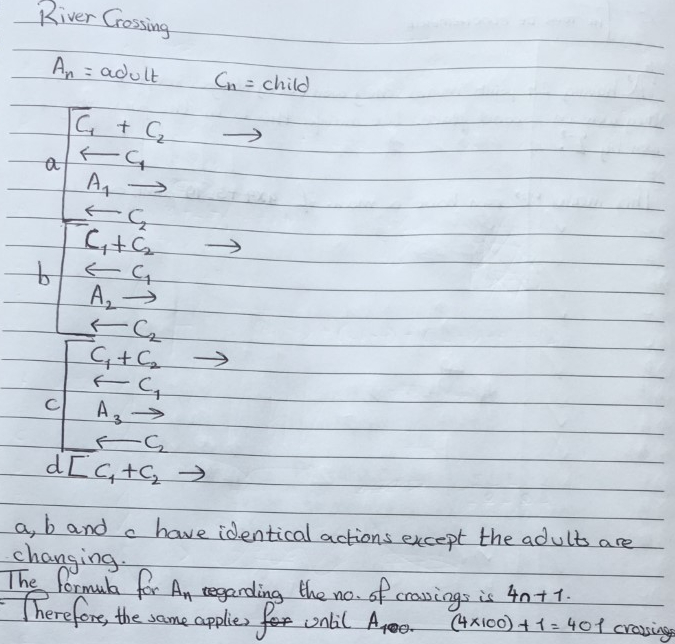Or search by topic
Number and algebra
Geometry and measure
Probability and statistics
Working mathematically
Advanced mathematics
For younger learners
River Crossing



- Problem
- Getting Started
- Student Solutions
- Teachers' Resources
Well done to everyone who found a solution to the problem about the farmer, the fox, the hen and the chicken. Those solutions are not included here, because the solution to that section is inluded in the problem.
Kaylie and Zoe from Frederick Irwin Anglican School in Australia explained how to get two adults and two children across the river:
Kid 1=A
Kid 2=B
Adult 1=C
Adult 2=D
1. Send A and B over
2. Send A back
3. Send C over
4. Send B back
5. Send A and B over
6. Send B back
7. Send D over
8. Send A back
9. Send A and B over
Year 5 from Wellington College Shanghai in China, Ci Hui Minh Ngoc from Kelvin Grove State College (Brisbane) in Australia, Rohan from Wilson's School in the UK, Ari and George from Frederick Irwin Anglican School, Henry and Zach from Wilsthorpe School and Matt from JMG le Clézio in Vanuatu extended this idea to 3 adults and to 100 adults. This is Ari and George's work:
Solution for problem #2
There are three adults, A1, A2 and A3, and two children, K1 and K2.
1. K1 and K2 go to side B.
2. K1 goes back to side A but K2 stays at side B.
3. A1 goes to side B.
4. K2 goes back to side A.
5. K1 and K2 go to side B.
6. K1 goes back to side A but K2 stays at side B.
7. A2 goes to side B.
8. K2 goes back to side A.
9. K1 and K2 go to side B.
10. K1 goes back to side A but K2 stays at side B.
11. A3 goes to side B.
12. K2 goes back to side A.
13. Finally, K1 and K2 go to side B together.
Solution for problem #3
There are two sides of the river, side A and side B. We have one-hundred adults, A1, A2 and so on, and two children, K1 and K2.
1. K1 and K2 go to side B.
2. K2 goes back to side A
3. A1 goes to side B. There is now one adult and one kid at side B.
4. K1 goes back to side A.
5. Repeat 99 times.
6. Finally, the kids go over in the same boat.
There is a pattern that both children go over, one child comes back, an adult goes over, one child comes back. No matter how many adults there are, this pattern will always work.
Sunhari from British School Muscat in Oman, Nayanika from The Tiffin Girls' School in the UK and Elliott and Ben from Frederick Irwin Anglican School used a diagram and a formula to represent this pattern. This is Nayanika's work:

Elliott and Ben also wrote a Python script which uses the formula to work out how many trips are needed for any number of adults that the user inputs. You can see the script here. The script also offers the user options to see the problem, to see how the formula works and to see the full explanation on this website.

